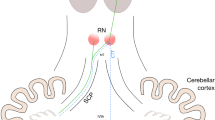Abstract
Purpose
To establish some explicit, feasible, and reproducible predictors for CMS.
Materials and methods
This study was a retrospective case study. Data were obtained from 82 patients with medulloblastoma at a single center, Beijing Tiantan Hospital. Based on medical records, we created two independent samples: the CMS group comprising 23 patients and the non-CMS group comprising 23 patients. Pre-operative imaging was studied by performing quantitative assessments of specific indicators.
Results
The CMS group showed greater differences in pre-operative imaging data with the non-CMS group. The Aaxi/daxi ratio in pre-operative MR imaging captured in the axial plane was used to quantify the compression of the cerebellum and brainstem, and significant differences were observed between the CMS group and non-CMS group (p = 0.0002). In the sagittal plane, Dsag*dsag was used to quantify the area of the tumor that invaded the brainstem, and significant differences were observed between the two groups (p = 0.0003). In the coronal plane, Acor/dcor was used to quantify the compression of the upper functional brain region, and significant differences were noted between the two groups (p = 0.0219). Additionally, Evans’ index was introduced to quantify the degree of hydrocephalus. The CMS group tended to show an increased Evans’ index (p = 0.0027).
Conclusion
Based on pre-operative imaging data, some reproducible predictors, such as Aaxi/daxi, Dsag*dsag, Acor/dcor, and Evans’ index, were established.

Similar content being viewed by others
References
Robertson PL, Muraszko KM, Holmes EJ, Sposto R, Packer RJ, Gajjar A, Dias MS, Allen JC (2006) Incidence and severity of post-operative cerebellar mutism syndrome in children with medulloblastoma: a prospective study by the Children’s Oncology Group. J Neurosurg 105:444–451. https://doi.org/10.3171/ped.2006.105.6.444
Beckwitt TS, Krieger MD, O'Neil S, Jubran R, Tavare CJ (2012) Symptoms before and after posterior fossa surgery in pediatric patients. Pediatr Neurosurg 48:21–25. https://doi.org/10.1159/000337730
Wells EM, Khademian ZP, Walsh KS, Vezina G, Sposto R, Keating RF, Packer RJ (2010) Post-operative cerebellar mutism syndrome following treatment of medulloblastoma: neuroratiographic features and origin. J Neurosurg Pediatr 5:329–334. https://doi.org/10.3171/2009.11.PEDS09131
Koh S, Turkel SB, Baram TZ (1997) Cerebellar mutism in children: report of six cases and potential mechanisms. Pediatr Neurol 16:218–219. https://doi.org/10.1016/S0887-8994(97)00018-0
Morris EB, Phillips NS, Laningham FH, Patay Z, Gajjar A, Wallace D, Boop F, Sanford R, Ness KK, Ogg RJ (2009) Proximal dentatothalamocortical tract involvement in posterior fossa syndrome. BRAIN 132:3087–3095. https://doi.org/10.1093/brain/awp241
Ellis DL, Kanter J, Walsh JW, Drury SS (2011) Posterior fossa syndrome after surgical removal of a pineal gland tumor. Pediatr Neurol 45:417–419. https://doi.org/10.1016/j.pediatrneurol.2011.09.011
Chua F, Thien A, Ng LP, Seow WT, Low D, Chang K, Lian D, Loh E, Low S (2017) Post-operative diffusion weighted imaging as a predictor of posterior fossa syndrome permanence in paediatric medulloblastoma. Childs Nerv Syst 33:457–465. https://doi.org/10.1007/s00381-017-3356-7
Catsman-Berrevoets C, Patay Z (2018) Cerebellar mutism syndrome. Handb Clin Neurol 155:273–288. https://doi.org/10.1016/B978-0-444-64189-2.00018-4
Doxey D, Bruce D, Sklar F, Swift D, Shapiro K (1999) Posterior fossa syndrome: identifiable risk factors and irreversible complications. Pediatr Neurosurg 31:131–136. https://doi.org/10.1159/000028848
McMillan HJ, Keene DL, Matzinger MA, Vassilyadi M, Nzau M, Ventureyra EC (2009) Brainstem compression: a predictor of post-operative cerebellar mutism. Childs Nerv Syst 25:677–681. https://doi.org/10.1007/s00381-008-0777-3
Charalambides C, Dinopoulos A, Sgouros S (2009) Neuropsychological sequelae and quality of life following treatment of posterior fossa ependymomas in children. Childs Nerv Syst 25:1313–1320. https://doi.org/10.1007/s00381-009-0927-2
Law N, Greenberg M, Bouffet E, Taylor MD, Laughlin S, Strother D, Fryer C, McConnell D, Hukin J, Kaise C, Wang F, Mabbott DJ (2012) Clinical and neuroanatomical predictors of cerebellar mutism syndrome. Neuro-Oncology 14:1294–1303. https://doi.org/10.1093/neuonc/nos160
Sergeant A, Kameda-Smith MM, Manoranjan B, Karmur B, Duckworth J, Petrelli T, Savage K, Ajani O, Yarascavitch B, Samaan MC, Scheinemann K, Alyman C, Almenawer S, Farrokhyar F, Fleming AJ, Singh SK, Stein N (2017) Analysis of surgical and MRI factors associated with cerebellar mutism. J Neuro-Oncol 133:539–552. https://doi.org/10.1007/s11060-017-2462-4
Ding Y, McAllister JN, Yao B, Yan N, Canady AI (2001) Axonal damage associated with enlargement of ventricles during hydrocephalus: a silver impregnation study. Neurol Res 23:581–587. https://doi.org/10.1179/016164101101199045
Del BM, Zhang YW (1998) Cell death, axonal damage, and cell birth in the immature rat brain following induction of hydrocephalus. Exp Neurol 154:157–169. https://doi.org/10.1006/exnr.1998.6922
Di Rocco C et al (2011) Heralding cerebellar mutism: evidence for pre-surgical language impairment as primary risk factor in posterior fossa surgery. Cerebellum 10(3):551–562. https://doi.org/10.1007/s12311-011-0273-2
Funding
This study was funded by the Beijing Natural Science Foundation (7172041).
Author information
Authors and Affiliations
Corresponding author
Ethics declarations
Before the investigation, we received the approval of the Ethics Review Committee of the Beijing Tiantan Hospital
Conflict of interest
The authors declare that they have no conflict of interest.
Additional information
Publisher’s note
Springer Nature remains neutral with regard to jurisdictional claims in published maps and institutional affiliations.
Rights and permissions
About this article
Cite this article
Zhang, H., Liao, Z., Hao, X. et al. Establishing reproducible predictors of cerebellar mutism syndrome based on pre-operative imaging. Childs Nerv Syst 35, 795–800 (2019). https://doi.org/10.1007/s00381-019-04075-6
Received:
Accepted:
Published:
Issue Date:
DOI: https://doi.org/10.1007/s00381-019-04075-6




